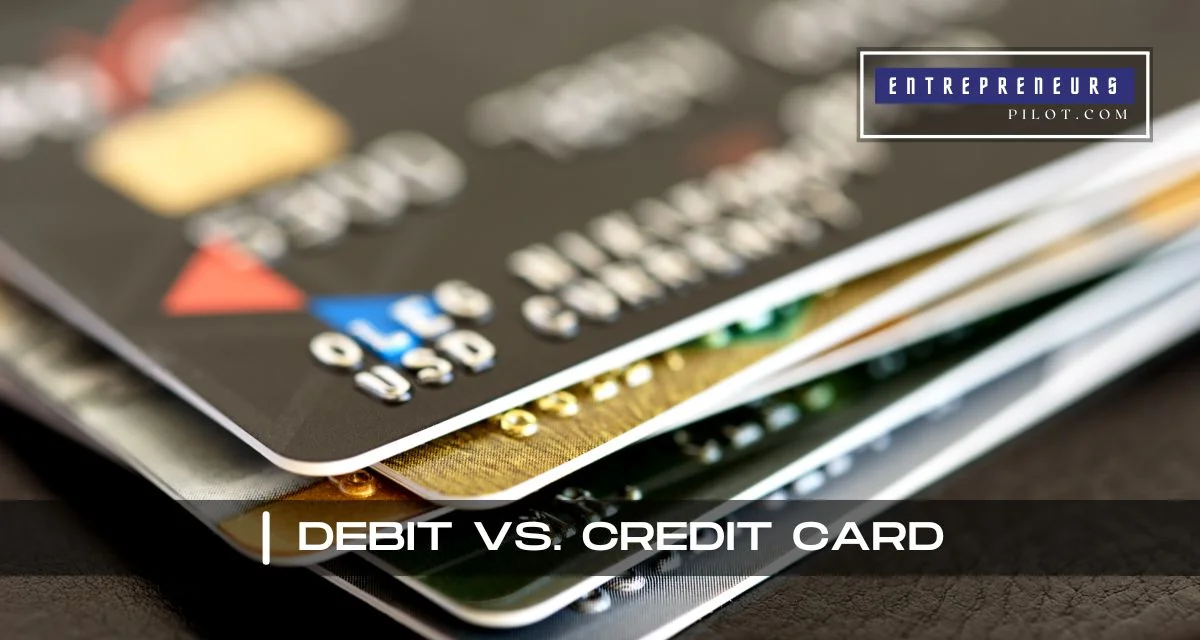Debit and credit cards might appear similar at first glance, yet understanding their key distinctions is integral for successful financial decision-making. Both payment options provide seamless means of transacting; however they operate on different principles in regards to accessing funds, applying interest rates, and offering protection from fraudulent activity.
Debit cards access funds directly from your checking account, acting like digital checks to ensure only spending what’s in the account; however, this type of card often doesn’t offer as many rewards or protection as its credit counterpart.
Credit cards provide access to credit, providing access to loans with predetermined limits that you may borrow against. Interest charges accrue if balances aren’t fully repaid on time but often come with benefits like reward points and travel perks as well as enhanced security measures.
Debit and credit cards both provide convenient ways for purchases, however understanding their individual features, benefits, and risks will allow for informed financial decision-making and more intelligent money management.
Table of Contents
Introduction
Inaugurating the content on this blog, the intention is to offer a concise preview of the realm encompassing debit cards and credit cards. The fundamental goal of this article resides in elucidating the pivotal distinctions that set apart these two classifications of payment cards. In doing so, we endeavor to provide readers with the tools to discern which card aligns most fittingly with their unique requisites. The content that ensues will encompass a comprehensive exploration into the essence and attributes of both debit and credit cards. Culminating this discourse, we will extend tailored recommendations, thereby facilitating the selection of the most appropriate card type for diverse segments of consumers.
- For Expert Financial Insights And Guidance, You Can Visit Our Sister Site – ArabsGeek.com Now!
- Curiosity Piqued? Dive Into the Most Captivating Financial Content by Visiting Our Homepage!
- Unlock Exclusive Business Opportunities! 🚀 Connect with Us Now at our Email: [email protected]!
The Topic Of The Blog Post (Debit vs. Credit Card)
- The primary focus of this blog post entails delving into the intricacies that underscore the distinguishing factors between debit cards and Credit Cards.
- Debit cards function as payment cards intricately linked to either a checking or savings account. They empower consumers to conduct purchases or withdraw cash, utilizing funds present within the associated account. Typically administered by financial institutions, these cards often hold affiliations with major payment networks such as Visa, Mastercard, and others.
- In sharp contrast, Credit Cards extend the ability for consumers to access borrowed funds. This enables them to make purchases or extract cash, obligating them to subsequently repay the borrowed amount along with accrued interest over an extended span. These cards emanate from diverse financial sources including banks, credit unions, and other financial entities.
- Both debit and Credit Cards present the inherent advantages of expediency and transactional security. Nonetheless, they diverge in terms of attributes, charges, and interest rates. The forthcoming discourse will delve comprehensively into these distinctive elements, casting light on the intricate dynamics of each.
Brief Overview Of The Main Points That Will Be Discussed In The Post
In this blog post, we will be discussing the key differences between Debit Cards and Credit Cards.
- Our journey will commence with a comprehensive elucidation, encompassing well-defined explanations and real-world instances, meticulously unraveling the operational mechanisms of both card categories.
- Following this, we will embark on an in-depth exploration into the key facets that set these two types apart. This expedition into differentiation shall encompass the realms of charges, interest rates, credit ceilings, incentives programs, and the security attributes they embody.
- Within the annals of this article, readers will also find tailor-made recommendations. These personalized insights will assist individuals in determining the card type that aligns most harmoniously with their distinctive profiles. The culmination of these insights will furnish readers with the knowledge requisite for making prudent decisions.
- By the time you conclude this read, a panoramic comprehension of the nuanced advantages and potential drawbacks tied to both debit cards and Credit Cards will have been crafted. Armed with this understanding, readers will be poised to render an enlightened choice—one that resonates with their unique financial requisites.
Differences between Debit and Credit Card
Differences between Debit vs. Credit Card
Debit cards and Credit Cards, while both falling under the realm of payment cards, exhibit distinct modes of operation. A debit card functions as a payment card intricately tethered to either a checking or savings account. This affords consumers the privilege of effecting purchases or cash withdrawals by utilizing the existing funds within the corresponding account. This category of cards is typically dispensed by financial institutions and tends to bear associations with prominent payment networks such as Visa, Mastercard, and others of the like.
In contrast, a Credit Card introduces the concept of borrowing, enabling consumers to procure goods or extract cash by leveraging borrowed funds. Subsequently, these borrowed funds need to be repaid, gradually, over time, accompanied by accruing interest. This category of cards emerges from a varied spectrum of financial sources, including banks, credit unions, and various other financial establishments. As a unified trait, both debit and Credit Cards extend the virtues of convenience and transactional security. However, they diverge across the realms of attributes, charges, and interest rates, which will be exhaustively delved into within the course of this post.
How Debit vs. Credit Card Differ In Terms Of Usage And Functionality
Debit and Credit cards differ considerably when it comes to how they access funds; their main difference lies in how these two card types access them; this difference stems from their various functions: for instance, debit cards enable users to make purchases or withdrawal cash using funds already present within an associated checking or savings account; on the contrary, Credit Cards allow individuals to borrow funds in order to carry out transactions or withdrawals of funds from an ATM machine or cash machine.
Debit cards enable financial transactions where expenditure is strictly tied to available balance in accounts; thus limiting spending scope to existing funds. With Credit Cards however, users enter an altogether different realm where spending exceeds immediate means and results in debt accumulation that must eventually be paid back along with interest payments.
Furthermore, these diverging approaches produce implications in terms of fees and interest rates for financial transactions. Debit cards generally carry lower fees and interest rates when compared with credit cards – although credit cards compensate with rewards and opportunities to strengthen one’s credit profile.
Advantages And Disadvantages Of Each Payment Method
Debit cards and Credit Cards each have their own advantages and disadvantages.
Debit cards present an effortlessly convenient avenue for accessing funds directly from linked checking or savings accounts. Notably, they are renowned for their tendency to be accompanied by fewer fees and interest rates that are comparably lower than those associated with Credit Cards. Moreover, these cards offer an inherently secure alternative for individuals who seek to avoid the pitfalls of exceeding their financial means or grapple with challenges in managing credit obligations. It is worth noting, however, that debit cards might impose limitations on the extent of withdrawals or expenditures, potentially restricting financial maneuverability. Furthermore, the rewards and avenues for cultivating creditworthiness that are intrinsic to Credit Cards may not be as pronounced within the realm of debit cards.
Stepping into the domain of Credit Cards unveils an augmented panorama of financial freedom. They extend a higher degree of flexibility in terms of expenditures, as they empower users to access borrowed funds, facilitated by a predetermined credit limit. Remarkably, Credit Cards frequently accompany a suite of enticements such as cashback incentives, redeemable points, or travel miles, catering to the preferences of enthusiastic shoppers. However, this privilege is tempered by the reality of elevated interest rates and the possibility of elevated fees. Striking a cautionary note, Credit Cards, if not wielded judiciously, can inadvertently instigate overspending and precipitate debt accumulation. Approval for Credit Cards mandates a credit assessment and hinges upon possessing a commendable credit score—an essential prerequisite.
How Debit vs. Credit Cards are Used
How Debit Cards Are Used For Everyday Transactions
Debit cards shine as the go-to companions for a multitude of daily transactions, seamlessly facilitating tasks ranging from routine purchases and bill payments to swift cash withdrawals at ATMs. When the moment comes to finalize a purchase, the user executes a straightforward motion—either a swipe or an insertion of the debit card into a card reader—followed by the input of a personal identification number (PIN). In a matter of moments, the sum equivalent to the purchase value is subtracted from the closely intertwined checking or savings account.
The versatility of debit cards extends to the realm of digital commerce, allowing users to effortlessly conduct online transactions. This is achieved through the utilization of vital card details—the card number, expiration date, and security code.
Furthermore, the utility of debit cards amplifies to encompass the realm of cash withdrawals from ATMs. In this scenario, the user seamlessly enters their unique PIN and specifies the desired withdrawal amount. In response, the ATM promptly dispenses the requested cash, accompanied by a transaction receipt that encapsulates the finer transaction details.
Collectively, the essence of debit cards resides in their capacity to offer a streamlined and accessible avenue for harnessing funds from a linked account. This innate simplicity underpins their relevance in facilitating transactions, be it within the physical realm of in-store purchases or the digital realm of online commerce.
How Credit Card Can Be Used For Various Types Of Purchases, Including Online And International Transactions
- Credit cards serve as versatile payment instruments with the versatility to support all sorts of transactions – from online shopping sprees to international expenditure.
- Credit Card owners enjoying in-store shopping experiences with ease by quickly and seamlessly inserting or swiping their card into a designated reader, charging their goods or services back onto their associated credit account as seamlessly as possible – creating an exemplary shopping experience!
- Utilizing Credit Cards to navigate the digital marketplace is straightforward. Simply inputting their identifying details such as their card number, expiration date and security code serves to authorize an online purchase during virtual checkout process.
- Credit Cards have gained tremendous international renown due to their international applicability; not only are these cards widely accepted globally but they also come equipped with currency conversion capabilities allowing users to shop without worrying about fluctuating exchange rates and rate fluctuations.
- Credit Cards add even more sparkle to their appeal with the array of enticing rewards and exclusive benefits they bestow upon cardholders, from cashback incentives, loyalty points or travel miles – each convertible into valuable discounts on products and services as well as complimentary flights or luxurious hotel stays.
- Credit Cards have evolved beyond simple transactional tools to become powerful financial partners, offering an extensive variety of options that cater specifically to various buying needs. Their inherent conveniences and additional perks have become highly desired options among modern consumers.
Comparison Of The Fees Associated With Using Debit vs. Credit Card
- When delving into the realm of transactional economics, the intricacies of interchange and processing fees come to the forefront, bearing distinctive traits for debit and Credit Card transactions.
- In the landscape of debit card transactions, the stage is set with an interchange fee that tends to hover around an approximate value of $0.24 for every payment executed. Contrastingly, the canvas of credit card transactions paints a more nuanced picture, wherein processing fees unfold as a multifaceted entity. Typically, these fees are known to manifest within the range of 2.87% to 4.35% of the transaction total. It’s crucial to note that these values do not encompass the inclusion of merchant service provider fees, which contribute an additional layer of complexity to the financial equation.
- Zooming in on the realm of Credit Card transactions, April 2021 bore witness to a fee structure set at 1.15% coupled with an additional $0.05 per transaction. A notable transition ensued in April 2022, orchestrating a reduction in this fee to 1.05% along with a mere $0.03 addition per transaction.
- Intriguingly, the orchestra of fees is further composed by the processor’s markup component. This layer can adopt varying proportions, typically oscillating between 0.75% and 0.9% of the transaction total. As an encore, it is adorned with an accompaniment of monetary values, with figures ranging from $0.13 to $0.22.
- Amidst this complex symphony, Payment Service Providers (PSPs) offer a simplified sonnet in the realm of pricing. With an inclination towards straightforwardness, they embrace a flat rate structure that harmonizes with the landscape of transactions. These rates stand tall, unburdened by the weight of monthly fees or supplementary charges, resonating with the ethos of transparency in financial dealings.
Security and Protection
Discussion of The Security Features Of Debit vs. Credit Card
In the realm of financial transactions, Credit Card and debit cards stand as two stalwart pillars, each offering a tapestry of convenience and security to users. The allure of Credit Card is crowned with a captivating feature known as Zero Liability protection, casting a protective shield over cardholders in the face of unauthorized purchases. Under this benevolent cloak, the onus of responsibility is lifted from the shoulders of users when unauthorized transactions come into play. Debit cards, embracing a contrasting narrative, weave their own narrative of safeguarding, orchestrating a defense mechanism against the specter of fraud. Herein lies the stipulation that the cardholder must act within a mere 48 hours to report any unauthorized charges.
Both credit and debit cards are imbued with layers of security, artfully encompassing elements such as the robust EMV chips, magnetic strips, and expiration dates. It’s noteworthy that the dynamic landscape also boasts an intriguing facet—debit cards embodying credit card-like protection, blurring the traditional demarcation lines. On the flip side, credit cards have responded to the winds of change by gracefully shedding the burden of annual fees, unveiling a landscape that’s friendlier to the pockets of users.
As users navigate the crossroads of choice, the compass points towards careful consideration of the myriad fees and benefits sewn into the fabric of each card. This deliberation process serves as a lodestar, guiding the seeker to a well-informed decision that aligns harmoniously with individual needs and preferences.
The Protection And Insurance Offered By Each Payment Method
The concept of insurance stands as a guardian angel, extending its wings of financial safeguarding in times of unforeseen adversity like accidents, illnesses, or unexpected twists of fate. Amid this landscape, payment methods like credit cards, debit cards, and prepaid cards emerge as torchbearers of added protection, offering a tapestry of insurance benefits that cocoon cardholders against losses that arise from theft, fraud, or the capricious dance of unexpected events.
Credit card companies don the mantle of guardianship with a trio of insurance offerings. The first chord resonates with the notes of purchase protection, a shield that blankets cardholders against the shadows of buyer’s remorse, extending a sheltering hand against the vagaries of post-purchase regret. The second, akin to the prolonging echo of an enchanting melody, manifests as extended warranty insurance, stretching the security of warranty coverage to envelop the cardholder in a cloak of peace of mind. The third refrain emerges as return protection insurance, ensuring that the echo of buyer’s remorse does not resound too loudly, allowing for the safe return of purchased items that might not have found their rightful place in the heart.
Meanwhile, debit cards, too, orchestrate their own symphony of safeguarding. The refrain of unauthorized transactions coverage offers a tune of protection, a musical solace against the dissonance of unauthorized financial activities. Prepaid cards, donning their own armor, conjure a shield against the specter of loss or theft, embracing cardholders within its protective embrace, even in the face of misfortune.
Venturing into the realm of wanderlust, payment methods unveil yet another verse, this one resonating with the notes of travel insurance. In this harmonious ensemble, we find the timbre of trip cancellation and interruption insurance, a melody that echoes a safety net when unforeseen disruptions cast a shadow on travel plans. Lost or delayed luggage coverage adds its own soothing note, cradling travelers in the reassurance that their belongings are not lost to the abyss. The crescendo of medical evacuation coverage stands as the final note, ensuring that even amidst the unpredictability of travel, a cardholder’s well-being remains a paramount consideration.
In the grand tapestry of financial security, insurance weaves its threads of protection, turning the spotlight on payment methods that stand as sentinels against the uncertainties of life’s unfolding chapters.
Comparison Of The Liability For Fraudulent Transactions
Distinguishing between the realms of fraudulent and disputed transactions unveils a significant contrast that merits understanding. Grasping this distinction is crucial, as it defines the realm of financial responsibility in the realm of unexpected financial activities. The Fair Credit Billing Act orchestrates a protective dance, declaring that fraudulent credit card transactions bear a maximum liability of $50, an emblem of reassurance amidst the turbulent seas of unauthorized activities.
In parallel, the stage shifts to the Electronic Funds Transfer Act, where debit cards assume their own role in this narrative. Here, a nuanced choreography comes to life. If a debit card is reported as lost or stolen within the first two days of its absence, a security net of $50 cushions the impact of the unforeseen. Yet, beyond this timeframe, the rhythm changes. The curtain rises to reveal an altered landscape; the liability amplifies to $500, casting a light on the importance of swift action. However, if time becomes a slipping thread, the story shifts once more, and the possibility arises that the responsibility for all fraudulent transactions rests upon one’s shoulders.
Engaging further, the process of disputing a transaction emerges as a subplot in this intricate narrative. As the curtain lifts, it reveals a window of up to 120 days, a temporal canvas upon which the resolution unfolds. The journey to dispute and secure a refund unfurls in this period, painting a canvas where patience and vigilance intertwine.
Standing as sentinels of fiscal well-being, the call to action resounds. The clarion call emphasizes the necessity of vigilance, a watchful gaze that traces the footprints of financial activities. Swift action is the protagonist of this narrative, urging the reporting of fraudulent or disputed transactions in the earliest breaths of their existence. This, then, is the crux of the tale – a tale where understanding, swift response, and attentive monitoring weave together, guarding against the shadows that may attempt to dance within the realms of financial transactions.
Conclusion
Recommendations For Choosing The Right Payment Method For Different Types Of Transactions
In the intricate process of selecting the most fitting payment method for an array of transactions, commercial enterprises must weigh multiple factors. Among these critical considerations are the overall cost of ownership, the nuanced preferences of their customer base, involuntary customer attrition, and the percentages of payments that fail to process. A meticulous optimization of payment strategies can alleviate concerns related to the movement of capital and bolster the all-important gross profit margins.
In the contemporary marketplace, credit and debit cards emerge as prevalent modes of payment. However, their widespread appeal does not come without a caveat: they generally command higher fees per transaction. In contrast, bank debit transactions frequently prove to be a more economical alternative, often contributing to a palpable reduction in the overall cost of sales.
The dynamic landscape of global commerce is also witnessing a growing trend towards the utilization of digital wallets and cash payment vouchers. These burgeoning methods of payment are gaining traction across international borders and should not be overlooked by forward-thinking businesses.
The potential ramifications of failed payments should be examined with due care, as they exert an influence on customer churn rates and the associated expenses of recovery. A failed payment is far more than a minor hiccup; it can have a ripple effect on both customer satisfaction and the bottom line.
To synthesize a payment strategy that harmonizes with both customer needs and fiscal objectives, businesses must allocate the time to rigorously assess their available options. By undertaking this vital analytical exercise, they can arrive at the optimal payment method, tailored to the unique demands of their clientele and the underlying financial structure of their operation. In this constantly evolving commercial environment, such conscientious planning can pave the way to both customer satisfaction and economic success.
Share your Experiences with Debit vs. Credit Card
Join our collective goal of improving debit and Credit Card usage experiences for everyone! Your experiences using these financial tools – both positive and negative – provide us with invaluable information. Whether it be successful transactions or any roadblocks along your journey – together we hold the potential for crafting user-centric systems! Share your views, join our adventure toward betterment!











